
Rediscovering Japan

Rediscovering Japan
Travel (Asakusa (Tokyo))

by tomizuta
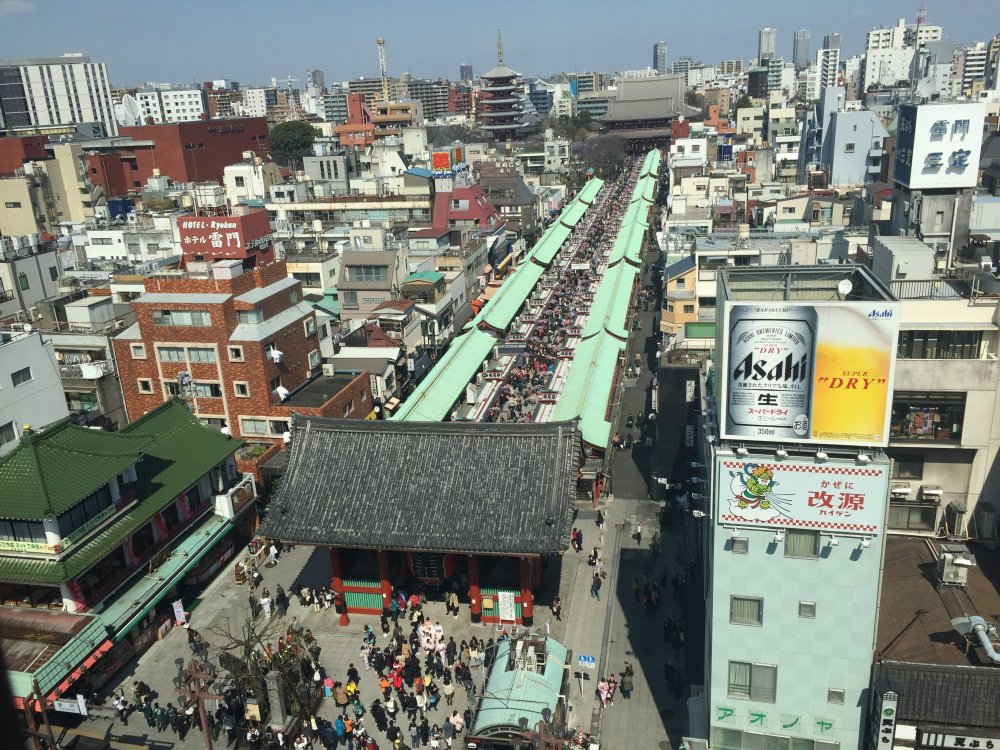
View of main street leading to Sensouji (Asakusa) Temple from the rooftop of Asakusa Culture Tourist Information Center
Asakusa is one of the most popular places
for travelers to Tokyo to visit to get a feel of the old city of Edo now Tokyo.
![]()
Our family life has led me to many places both in Japan and around the
world, so have visited, seen and enjoyed much. When an Australian lady
was here in Tokyo for the briefest of time it was a wonderful opportunity
to share back some memories for her to take home. But where to go in just
a short day? It didnft seem very difficult to choose Asakusa. Only thirty
minutes from her Shiodome hotel. The Asakusa neighbourhood grew and developed
from our earliest Edo Period (1603-1868), when Tokyo wasnft Tokyo but was
known as Edo. So, from the earliest part of the seventeenth century, Asakusa
grew and developed as part of the heart of Tokyofs enormous growth. Asakusa
then, like now, was a popular place for citizens, developing its own, unique,
cultural scene - Edo Bunka (culture). Not the same classical culture that
was fostered by the aristocracy and epitomised by life in Kyoto, Edo Bunka
was the real thing! It was born of the ordinary people. Unrestrained by
traditions, a new taste for art called Iki, the closest translation of
which may be smart or trendy, emerged in Edo. New styles of painting, acting,
music were all nurtured here. The origins of so much that represents our
cultural life to the world was born, grew up and continues to be cherished
here. Kabuki (our stylised drama), Haiku (seventeen syllable poetry), Ukiyoe
(pictures of everyday scenes). During the Edo period, the capital of Japan
continued to be Kyoto where the emperor resided, while the military government
(Bakufu) led by the Tokugawa Shogun under empowerment from the emperor
was based in Edo. The hierarchy of the emperor and his appointee, the Shogun
residing in Edo was clear, which was reflected in the spoken word culture
in the two regions. The highly elegant culture in Kyoto and surrounding
areas was called Kamigata (upper) culture, as opposed to the newly emerging
townsfolk Edo culture.
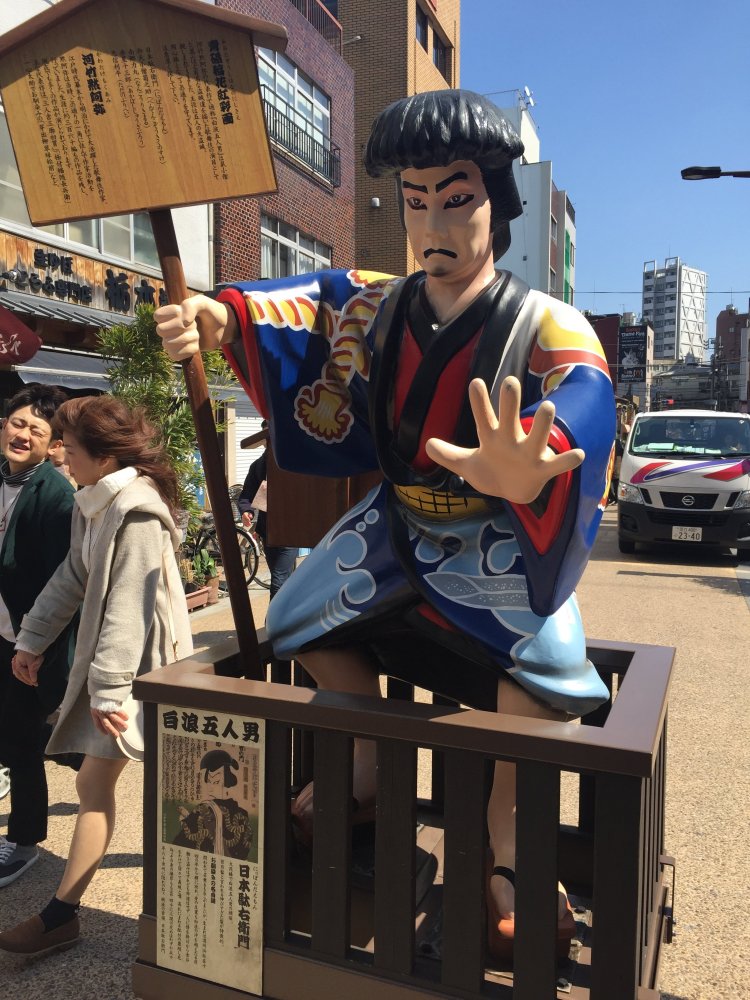
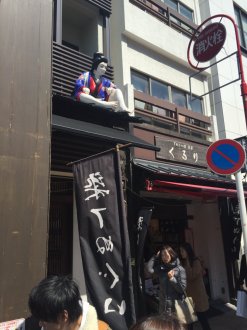
One of the five bandit Kabuki characters blocks you at Denpouin Street. Try to find the other 4 nearby.There's one on the right.
As the living standards of the townsfolk improved, and they found more
time to go and see Kabuki, enjoy Haiku, Ukiyoe and novels, the Tokugawa
military government became concerned that this may corrupt public morals.
The Bakufu therefore imposed restrictions on the publication of love related
material, banned performance of actresses in Kabuki, enacted a rule of
austerity designating to what extent people should dress and so forth.
The townsfolk managed by the introduction of Onna-Gata (male actors performing
female roles), using rich fabulous back lining for what they wore, and
developed an even more lively culture within the restrictions imposed by
the Bakufu.
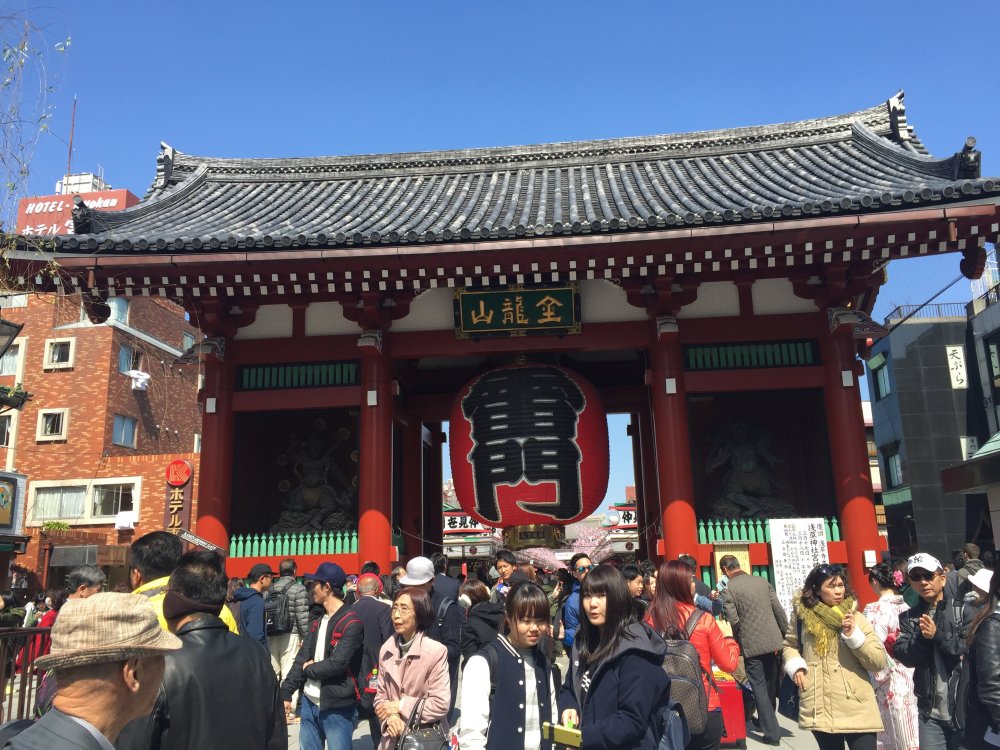
Kaminari-mon (thunder gate)
Once you go through the gate, a row of gift and snack shops appear on both
sides of the route leading to the main temple. It was customary for the
people in the Edo period to pay homage to the local temples and shrines.
They would pray for a good year on New Yearfs Day and wish from time to
time for safe delivery, business prosperity, and well-being of the family.
They would return to offer a prayer of thanks should a wish be granted.
Paying homage to temples and shrines was their entertainment as much as
it was a religious practice.
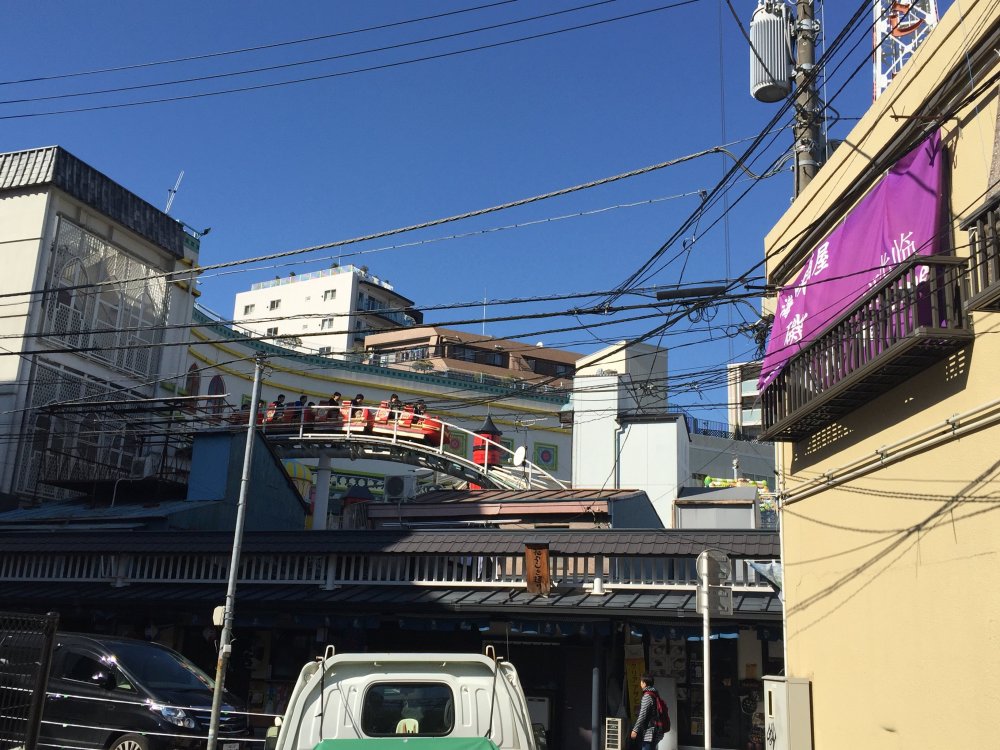
A glimpse of Hanayashiki amusement park
The first amusement parks called Hanayashiki (flower residence in Japanese)
appeared towards the end of the Edo period. Today, you can find in the
Asakusa area places to experience traditional Japanese culture such as
tea ceremonies, calligraphy and Japanese drums. You can also take a course
to master Shuriken, a deadly throwing knife that Ninjas used to use. And
why not enjoy a Jinrikisha ride on a man-pulled rickshaw.
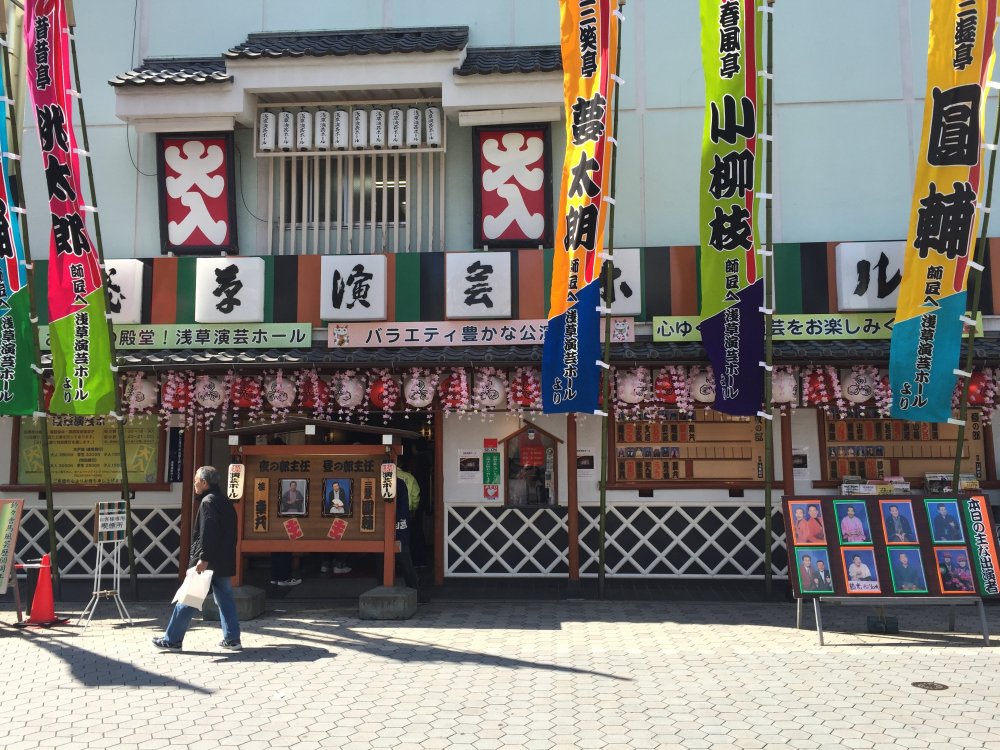
Front of a Yose, a comedy hall
It was a warm day, so we bought cold Maccha (heavy green tea) drinks at
one of the food stalls on the side of the entrance road to the main temple.
In winter they would be selling warmed Amazake (sweet sake, which is made
from the residues of sake brewing with only a slight alcohol content).
Itfs always fun to enjoy the drinks and sweets standing in a small space
under the eaves of the food shops. In the Edo period, there were merchants
that would call on peoplefs houses to sell food and sweets as well as household
goods. They would be pulling a cart carrying their merchandise. In winter
times they would be offering Yakiimo (baked sweet potatoes) and refreshing
Warabi Mochi (fern cakes) in summer. The customers felt the change of the
seasons by what was being sold, to the extent that Yakiimo and Warabi Mochi
became accepted as words representing winter and summer in Haiku. As you
may know, it is a rule to use such words representing the seasons in order
to be accepted as a Haiku.
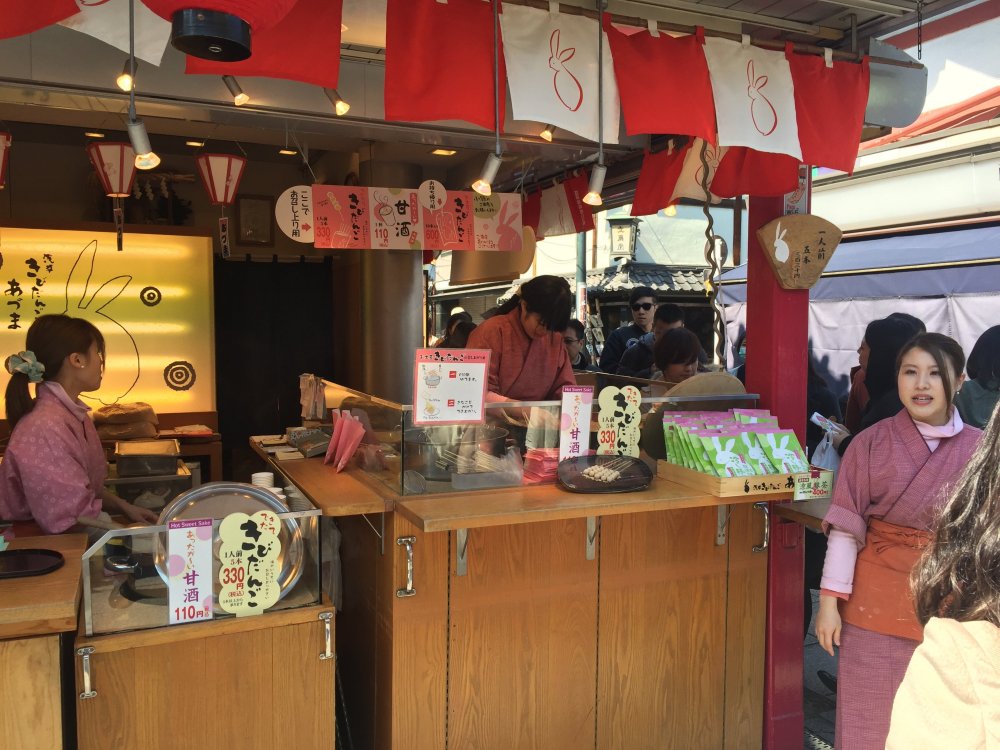
Try some warm Amazake for \110.
After enjoying a visit to the main temple, Udon noodles for lunch, we took
the river route to get back to the hotel in Shiodome. From the Edo to Meiji
period, the main transportation method of goods was by boat. Goods from
all parts of Japan would be transported by sea to the mouth of Sumida River,
where it would be divided into smaller lots to forward to the inland by
river or canals on small boats. We took a boat trip downstream on Sumida
River to Hama-rikyuu (Hama imperial villa) close to the hotel.
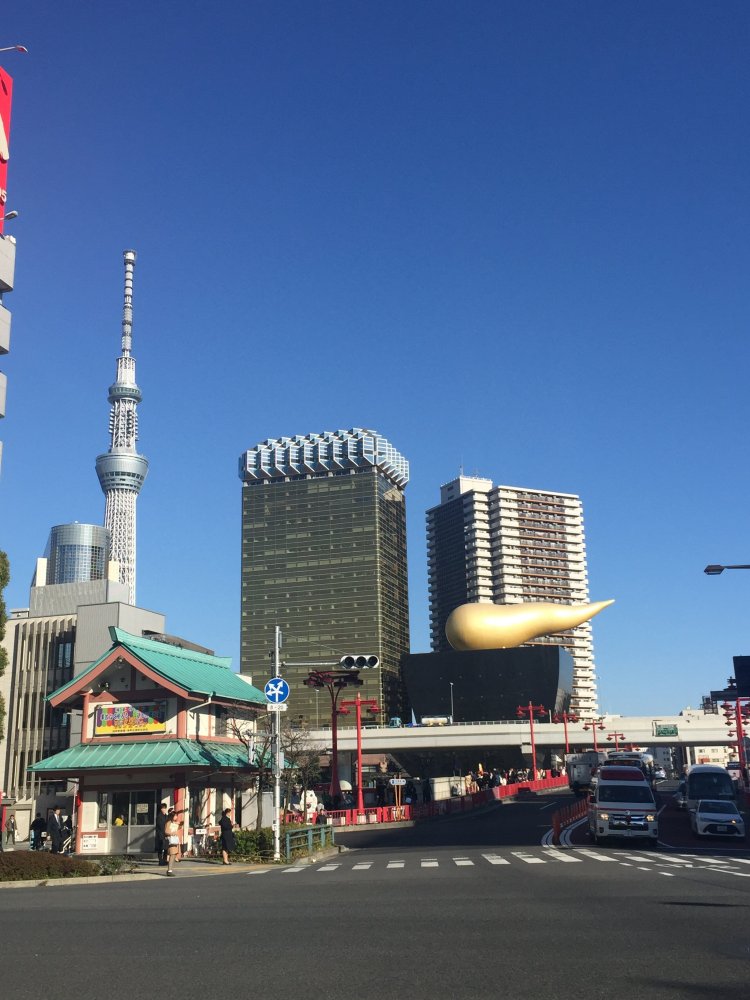
Flame d'or from AzumaBridge
Hama-rikyuu is within walking distance from Shimbashi Station, but it is
more enjoyable to go by boat as the Samurai used to for hawk hunting (falconry).
It was the Tokugawa Shogunsf hawk hunting place. The Edo period was a peaceful
time where there was no war for more than two hundred years after the Shimabara
(located in Nagasaki prefecture) up-rise in 1638AD. During such peaceful
times, it is thought that hawk hunting served as entertainment as well
as battle training. Hawk hunting must have been a big event where many
people (Seko) would be recruited to scare and woo the rabbits, pheasants
and other birds as prey for the hawks. It is said that the eighth Shogun
Yoshimune kept an elephant brought from outside of Japan in the villa grounds.